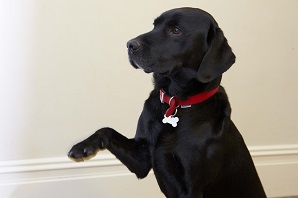Puppy Training Tips | How To Bond With Your Pet

It’s important that training starts within a few weeks of your new puppy settling in to their new home. Teaching basic commands will give you better control of your puppy, and help them understand what you want them to do.
Petplan takes a look at useful training tips to help you and your puppy build your relationship…
The three main objectives when training your puppy are to:
- Prevent your dog from being confused about what is being asked of them
- Establish control of your dog, enabling you to be a responsible dog owner
- Create a fun and responsive relationship with your puppy
Command training
Training your puppy to follow commands such as come, sit and stay is a fun and rewarding way to build and nurture your relationship and of course encourage good and safe behaviour.
Once your puppy has been taught these commands, get into the habit of using them throughout the day before activities, such as meals, walks, petting and playing.
Bear in mind young puppies lose concentration quickly, so, when teaching commands, it’s best to have a few short, five minute sessions per day and training must be reward based – such as using treats, toys and cuddles. Always finish any session on a high with an exercise you know your puppy can successfully complete.
How to teach these commands
Be clear, calm and consistent and teach one command at a time. Once your puppy has learnt one command you can move onto a second command.
A good command to start with is ‘sit’. A simple way to teach this is, whenever you happen to see your puppy about to sit, as their bottom touches the floor say ‘sit’ and they will begin to associate the action with the word.
Holding a treat in your fingers while slowly moving your hand closely over the top of your puppy’s head, will see most puppies automatically sit as they raise their head to follow the smell of the treat.
As before, when your puppy’s bottom hits the floor, say ‘sit’, and immediately give him the treat. After a few times of doing this you should be able to just say ’sit’ and your puppy will know what he needs to do.
If you dog doesn’t respond to the command, don’t shout, just step away and don’t reward them. Try again later when they are ready.
You can use a clicker to help with training. This method works by teaching dogs that the sound of the ‘click’ will be followed by a reward and enables owners to train with split second precision.
Rewarding good behaviour
As mentioned above, it’s important to praise puppies when they have responded correctly to commands with either spoken praise, treats, or toys. This is positive reinforcement and aims to ensure your puppy continues to display the required behaviours.
However, it’s also just as important to not react negatively to ‘bad’ behaviours. Puppies will no doubt ‘act up’ occasionally but instead of scolding them, simply ignore their behaviour.
This goes for behaviours such as:
- Begging for food at the table
- Jumping up
- Scratching furniture
They should quickly learn they will only be rewarded for good behaviour, which will reinforce them to behave well towards you and others.
If your puppy is doing something that you can’t ignore, such as chewing the furniture, squeak a toy to get their attention and encourage them to play with a chew toy instead. Praise them when chewing the toy instead.
Are you currently training a puppy? Or have any stories to share with anyone who is? Leave a comment below…

